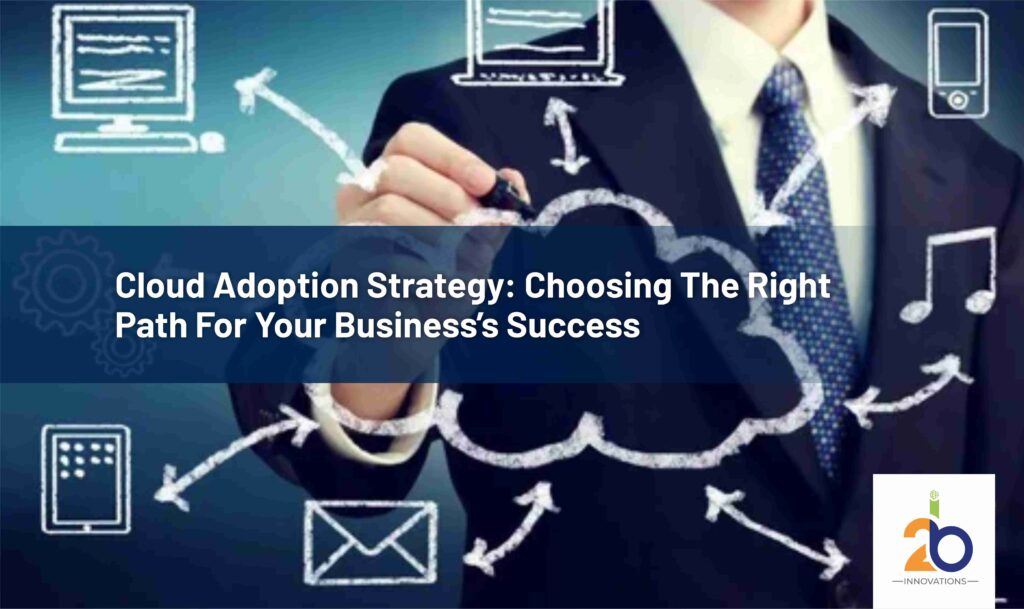
Have you ever felt your business lagging behind the competition?
In the present time where agility and scalability are crucial, many companies are turning to cloud computing for a strategic advantage.
Did you know that according to a Gartner study, 85% of businesses are expected to adopt a cloud-first strategy by 2025?
This shift towards cloud adoption is driven by its immense benefits, including cost savings, improved collaboration, and enhanced security. But navigating the world of cloud computing can be overwhelming.
That’s where a well-defined cloud adoption strategy comes in.
Keep reading.
By the end, you’ll be ready to confidently step forward on your cloud transformation journey.
What Is A Cloud Adoption Strategy?
A cloud adoption strategy is essentially a roadmap that outlines your business’s approach to migrating to and utilizing cloud computing services. It goes beyond simply moving your data and applications to the cloud.
A detailed strategy considers your overall business goals, identifies the most suitable cloud model, and defines a step-by-step plan for implementation.
Why Do You Need A Cloud Adoption Strategy?
Think of a cloud adoption strategy as the architect’s blueprint for building your dream digital home. Without a plan, haphazard cloud migration can lead to compatibility issues, security vulnerabilities, and unexpected costs.
A well-defined strategy ensures a smooth transition, maximizes the benefits of cloud computing, and sets your business up for long-term success.
Here are some compelling reasons why a cloud adoption strategy is vital:
- Cost Optimization
Cloud computing eliminates the need for expensive upfront hardware investments. You only pay for the resources you use, leading to significant cost savings. A study by McKinsey & Company found that 61% of organizations that adopted cloud computing as part of their digital transformation strategy experienced a revenue increase of at least 25%.
- Enhanced Scalability
Cloud-based applications and infrastructure can easily scale up or down based on your needs. This allows you to adapt to fluctuating demands without worrying about managing physical hardware limitations.
- Improved Agility & Innovation
Cloud computing fosters a culture of innovation by allowing businesses to experiment with new technologies and applications quickly and efficiently. This agility is especially crucial in today’s fast-paced business environment.
- Increased Collaboration
Cloud-based tools enable seamless collaboration among employees, regardless of their location. This is particularly beneficial for geographically dispersed teams.
- Enhanced Security
Leading cloud service providers (CSPs) invest heavily in robust security measures. Cloud infrastructure often offers better security features compared to in-house IT infrastructure, especially for smaller businesses lacking dedicated security resources.
Key Steps In Developing Your Cloud Adoption Strategy
Now that you have an understanding of the importance of cloud computing strategy, let’s get into the steps involved in crafting your own:
Step 1: Define Your Business Goals
Initially, you need to identify your overarching business goals. Are you aiming to improve operational efficiency, drive innovation, or enhance customer experience? Once you have a clear understanding of your objectives, you can tailor your cloud adoption strategy to achieve them.
Step 2: Assess Your Current IT Infrastructure
Evaluate your existing IT infrastructure, including hardware, software, applications, and data. This assessment will help you determine which applications and data are best suited for cloud migration.
Step 3: Choose the Right Cloud Service Provider (CSP)
The vast array of CSPs can be daunting. Research and compare different providers based on their service offerings, pricing models, security features, and compliance certifications. Consider factors like industry specialization and experience with similar businesses to yours.
Step 4: Select Your Cloud Deployment Model
There are three main cloud deployment models:
- Public cloud
- Private cloud
- Hybrid cloud
Public clouds, offered by providers like Amazon Web Services (AWS), Microsoft Azure, and Google Cloud Platform (GCP), are the most popular option, offering scalability and cost-effectiveness.
Private clouds offer a dedicated environment with increased control but at a higher cost.
Hybrid clouds combine elements of both public and private clouds, providing a flexible solution.
Step 5: Develop a Migration Plan
Craft a detailed migration plan outlining the sequence of applications and data to be migrated. Prioritize applications that will deliver the most significant benefits upon migration. Consider employing GenAI (Generative Artificial Intelligence) tools to automate repetitive tasks within the migration process, saving time and resources.
Step 6: Focus on Security & Compliance
Security should be a top priority throughout your cloud adoption journey. Implement robust security protocols and access controls to protect your sensitive data. Ensure your chosen CSP adheres to relevant industry regulations and compliance standards.
Step 7: Optimize for Performance
After migration, continuously monitor and optimize your cloud environment to ensure peak performance. Leverage cloud-native features like auto-scaling and automated resource provisioning to streamline operations and reduce costs.
Step 8: Change Management & Training
Don’t underestimate the importance of change management. Prepare your employees for the transition to the cloud by providing comprehensive training and support. This will help them adapt to new workflows and maximize the benefits of cloud-based applications.
Choosing The Right Cloud Model
Selecting the most suitable cloud deployment model depends on your specific business needs and priorities. Here’s a quick breakdown of the primary models to help you pick “The One” for you:
Public Cloud (Most Widely Adopted Model)
It offer a pay-as-you-go pricing structure, making them cost-effective for businesses of all sizes. Public clouds boast high scalability and readily available resources, perfect for businesses with fluctuating workloads. However, security concerns might arise due to the shared infrastructure nature of public clouds.
Private Cloud
This model provides a dedicated environment offering greater control and security. This model is ideal for businesses handling highly sensitive data or requiring strict regulatory compliance. However, private clouds can be more expensive to manage compared to public clouds due to the dedicated infrastructure.
Hybrid Cloud
It combines elements of both public and private clouds. This model offers increased flexibility by allowing businesses to store sensitive data or applications in the private cloud while leveraging the scalability and cost-effectiveness of the public cloud for other workloads. Managing a hybrid cloud environment can be more complex, requiring expertise in both public and private cloud technologies.
Examples of Cloud Adoption in Action
Here are some real-world examples of how businesses have leveraged cloud computing to achieve remarkable success:
Netflix
The streaming giant relies heavily on AWS to deliver its vast content library to millions of subscribers globally. Cloud-based infrastructure enables Netflix to scale its resources effortlessly to meet peak demand during popular releases.
Dropbox
Dropbox, the popular file storage and sharing service, utilizes AWS for its core infrastructure. The cloud provides Dropbox with the scalability and reliability needed to handle its ever-growing user base.
Airbnb
Airbnb utilizes a hybrid cloud strategy, with core applications running on a private cloud for enhanced security and compliance. They leverage the public cloud for tasks requiring high scalability, such as data analysis and machine learning.
Final Words
Cloud computing offers a transformative opportunity for businesses of all sizes. By crafting a well-defined cloud adoption strategy, you can unlock the immense benefits of cloud technology, from cost savings to enhanced agility and innovation. Remember, the cloud journey is an ongoing process.
Continuously monitor your cloud environment, adapt your strategies as needed, and embrace a culture of continuous learning to maximize the return on your cloud investment.
Ready to embark on your cloud transformation journey?



